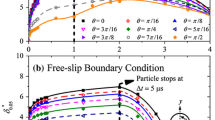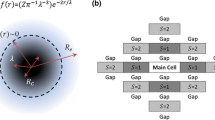Abstract
A numerical simulation based on a combined Euler and Lagrange method is investigated in this work to simulate the flow and migration of nanoparticles in a single channel. The motion of discrete nanoparticles is determined by the Lagrangian trajectory method based on the Newton’s second law that includes the influence of the body force, various hydrodynamic forces, the Brownian motion and the thermophoresis force. The coupling of discrete particles with continuous flow is realized through the modification of the source term of the continuous equation. The results reveal the two-phase flow nature of nanoparticle suspensions and their implications to the convective heat transfer of nanofluids.




Similar content being viewed by others
Abbreviations
- c :
-
Specific heat (J/kg K)
- C s :
-
Coefficient in Eq. 17
- C t :
-
Coefficient in Eq. 17
- C m :
-
Coefficient in Eq. 17
- d p :
-
Particle diameter (m)
- d ij :
-
Deformation tensor
- D T,p :
-
Thermophoretic coefficient
- F :
-
Force acting on the particle (N/kg)
- F D :
-
Drag force (N/kg)
- F G :
-
Gravity (N/kg)
- F B :
-
Brownian force (N/kg)
- F T :
-
Thermophoretic force (N/kg)
- F L :
-
Saffman’s lift force (N/kg)
- F P :
-
Pressure gradient force (N/kg)
- F V :
-
Virtual mass force (N/kg)
- g :
-
Gravity acceleration (m/s2)
- I :
-
Unit vector
- k :
-
Thermal conductivity of nanofluid (W/mK)
- k p :
-
Particle thermal conductivity (W/mK)
- K :
-
Thermal conductivity ratio (k/k p)
- k B :
-
Boltzmann constant
- K n :
-
Knudsen number
- K s :
-
Coefficient
- m p :
-
Mass of the particle (kg)
- p :
-
Pressure of liquid phase (Pa)
- Pe :
-
Peclet number
- R :
-
Radius (m)
- Re :
-
Reynolds number
- S 0 :
-
Spectral intensity basis
- S n,ij :
-
Spectral intensity
- S p :
-
Source term
- t :
-
Time (s)
- T l :
-
Stress tensor of nanofluids
- T :
-
Temperature (K)
- v :
-
Velocity of nanofluid (m/s)
- v l :
-
Fluid phase velocity (m/s)
- v p :
-
Particle velocity (m/s)
- Β :
-
Inter-phase momentum exchange coefficient
- ρ l :
-
Fluid density (kg/m3)
- λ :
-
Mean free path of the fluid (m)
- δ ij :
-
Kronecker delta function
- ζ i :
-
Zero-mean, unit-variance-independent Gaussian random number
- μ l :
-
Dynamic viscosity of nanofluids (kg/ms)
- ν :
-
Kinetic viscosity (m2/s)
References
Ahuja AS (1975) Augmentation of heat transport in laminar flow of polystyrene suspensions II. Analysis of the data. J Appl Phys 46:3417–3425
Buongiorno J (2006) Convective transport in nanofluids. J Heat Transf 128:240–250
Chen HS, Ding YL, Tan CQ (2007) Rheological behavior of nanofluids. New J Phys 9:1–25
Ding YL, Alias H, Wen DS, Williams RA (2006) Heat transfer of aqueous suspensions of carbon nanotubes (CNT nanofluids). Int J Heat Mass Transf 49:240–250
Ding YL, Wen DS (2004) Particle migration in a flow of a suspension of nanoparticles (nanofluids). Powder Technol 149:84–92
Eapen J, Li J, Yip S (2007) Mechanism of thermal transport in dilute nanocolloids. Phys Rev Lett 98:028302
Keblinski P, Phillpot SR, Choi SUS, Eastman JA (2002) Mechanisms of heat flow in suspensions of nano-sized particles (nanofluids). Int J Heat Mass Transf 45:855–863
Koo J, Kleinstreuer C (2005) Laminar nanofluid flow in microheat-sinks. Int J Heat Mass Transf 48:2652–2661
Kulkarni DP, Das DK, Chukwu GA (2006) Temperature dependent rheological property of copper oxide nanoparticles suspension (nanofluid). J Nanosci Nanotechnol 6:1150–1154
Heris SZ, Esfahany MN, Etemad G (2006) Investigation of CuO/water nanofluid laminar convective heat transfer through a circular tube. J Enhanc Heat Transf 13:279–289
Heris SZ, Esfahany M, Etemad S (2007) Experimental investigation of convective heat transfer of Al2O3/water nanofluid in circular tube. Int J Heat Fluid Flow 28:203–210
Leighton D, Acrivos A (1987) The shear-induced migration of particles in concentrated suspensions. J Fluid Mech 181:415–439
Lee J, Mudawar I (2007) Assessment of the effectiveness of nanofluids for single-phase and two-phase heat transfer in micro-channels. Int J Heat Mass Transf 50:452–463
Li A, Ahmadi G (1992) Dispersion and deposition of spherical particles from point sources in a turbulent channel flow. Aerosol Sci Technol 16:209–226
Maïga S, Nguyen C, Galanis N, Roy G (2004) Heat transfer behaviours of nanofluids in a uniformly heated tube. Superlattices Microstruct 35:543–557
Prakash M, Giannelis EP (2007) Mechanism of heat transport in nanofluids. J Comput Aided Mater Des 14:109–117
Roy GC, Nguyen CT, Comeau M (2006) Numerical investigation of electronic component cooling enhancement using nanofluids in a radial flow cooling system. J Enhanc Heat Transf 13:101–115
Sohn CW, Chen MM (1984) Heat transfer enhancement in laminar slurry pipe flow with power law thermal conductivities. ASME J Heat Transf 106:539–542
Saffman PG (1965) The lift on a small sphere in a slow shear flow. J Fluid Mech 22:385–400
Talbot L (1980) Thermophoresis of particles in a heated boundary layer. J Fluid Mech 101:737–758
Tseng WJ, Lin KC (2003) Rheology and colloidal structure of aqueous TiO2 nanoparticle suspensions. Mater Sci Eng A 355:186–192
Wen DS, Ding YL (2004) Experimental investigation into convective heat transfer of nanofluids at the entrance region under laminar flow conditions. Int J Heat Mass Transf 47:5188–5281
Wen DS, Ding YL (2005) Particle migration and heat transfer in suspensions of nanoparticles flowing through minichannels. Microfluid Nanofluid 1:183–189
Wen DS, Ding YL (2006) Natural convective heat transfer of suspensions of TiO2 nanoparticles (nanofluids). Trans IEEE Nanotechnol 5:220–227
Xuan YM, Roetzel W (2000) Conceptions for heat transfer correlation of nanofluids. Int J Heat Mass Transf 43:3701–3707
Yang Y, Grulke EA, Zhang ZG et al (2005) Rheological behavior of carbon nanotube and graphite nanoparticle dispersions. J Nanosci Nanotechnol 5:571–579
Yang Y, Zhang Z, Grulke E, Anderson W, Wu G (2005) Heat transfer properties of nanoparticle-in-fluid dispersions (nanofluids) in laminar flow. Int J Heat Mass Transf 48:1107–1116
Acknowledgments
The authors would like to extend their thanks to EPSRC for financial support under Grant EP/E065449/1.
Author information
Authors and Affiliations
Corresponding author
Rights and permissions
About this article
Cite this article
Wen, D., Zhang, L. & He, Y. Flow and migration of nanoparticle in a single channel. Heat Mass Transfer 45, 1061–1067 (2009). https://doi.org/10.1007/s00231-009-0479-8
Received:
Accepted:
Published:
Issue Date:
DOI: https://doi.org/10.1007/s00231-009-0479-8




